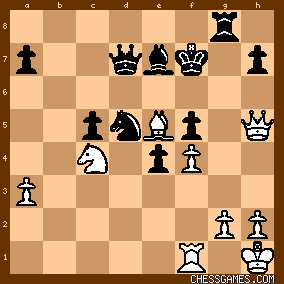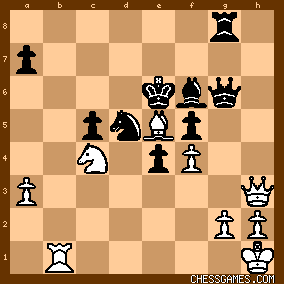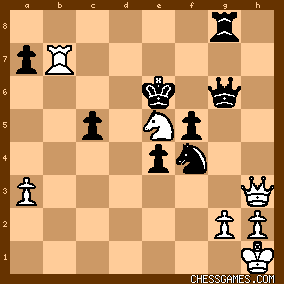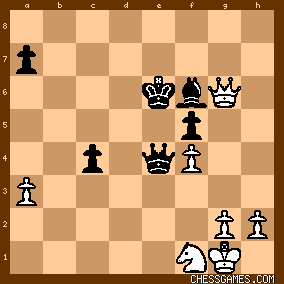|
< Earlier Kibitzing · PAGE 2 OF 3 ·
Later Kibitzing> |
Aug-14-06
 | | Honza Cervenka: 29.Rh3 would have made serious troubles to black. 29...Qb5 fails for 30.Qh5! Qxc4 (30...Qxd5 31.Nxd6 Qxd6 32.Qxh7 Rg6 33.g4 fxg4 34.f5  ) 31.Qh4+ Kf7 32.Qxh7+ Kf8 33.Qxf5+ Ke5 34.Qe6+ etc. So 29...Rxc4 looks forced but it is hardly survivable. ) 31.Qh4+ Kf7 32.Qxh7+ Kf8 33.Qxf5+ Ke5 34.Qe6+ etc. So 29...Rxc4 looks forced but it is hardly survivable. |
|
Aug-14-06
 | | tamar: 29 Rh3! is a high level improvement, but I am disappointed that Anderssen did not see it during play. After another defensive try, 29...Bc7 30 Ne3! would emphasize the hopelessness of Black's position focussing on the weak f5 pawn, and bringing the rook to h5. Since Morphy did not annotate these games, we cannot know if he was aware of his narrow escape. |
|
Aug-15-06
 | | Honza Cervenka: <tamar> To miss move like 29.Rh3 is not difficult, especially if black can answer it with 29...Qb5 pinning the Knight c4. I think that this was the reason why Anderssen gave the check at first with Queen on b2 and played Rh3 only one move later which was not as efficient as it could have been in move 29. He probably did not notice that after 29.Rh3 Qb5 he could have played 30.Qh5!! with devasting impact due to weak spots (h7, f5, e6) allowing decisive intrusion of white Queen. But I am much more disappointed by 40.Rxe3?? which is completely incomprehensible to me. Was he missing the fact that e8 is covered by black Queen? Only great exhaustion, some mirage or severe time pressure (but it is not possible here as they did not use clock then) can explain such a blunder of player of Anderssen's calibre. Anyway, this game doesn't attest that he played in his top form with Morphy. |
|
Aug-15-06
 | | tamar: Apparently Anderssen later became aware he missed several wins because Zukertort did an analysis of the games. Time was not a factor, as this game lasted 8 hours, but exhaustion certainly could have played a part. Zukertort pointed to 28 Rh3 as the winning move, and it would appears to transpose with the lines given by <Honza Cervenka> a move later, although Sergeant does not give the 2 pages of lines. The only difference could be if Black moved his rook to protect the f6 pawn, but this looks bad for Black as well. After 28 Rh3 Rcf8 29 Bxf6+ Rxf6 30 Rxh7+ Rf7 31 Rxf7+ Kxf7 32 Qh5+ Kf6 33 Qh4+ Kg7 34 Qg5+ Kh7 35 Qh5+ Kg7 36 Ne5
Bxe5 37 fxe5 White is just winning by force.
For example 37...Qxd5 38 Rxf5 
click for larger view |
|
Aug-15-06
 | | Honza Cervenka: <tamar> That seems to be right. But 28.Bxf6+ Kxf6 29.Rh3 is technically more accurate order of moves as it eliminates 28...Rcf8 defense.:-) |
|
Aug-15-06
 | | tamar: <I am much more disappointed by 40.Rxe3?? which is completely incomprehensible to me.> Lawson gives an spectator's impressions by George Walker, published in "Bell's Life in London" "Anderssen's great soul seems occasionally broken by the prospect of almost certain defeat, and he plays with comparative difficulty, and 'don't care-ishness'..." I don't know how to explain the blunder 40 Rxe3 though, except perhaps that he overlooked 39...e3, which despite all his White's second best moves, looks like the only way for Black to draw. For example, 39...Rc8 40 Qf6 Qe8 41 Ne5 Rxc3 42 d7 is indicated by Shredder 8 as Black's best but losing line. So perhaps a combination of surprise at Morphy for finding a miracle resource, and his own exhaustion at not being able to finish off a brilliant conception for 12 moves, made Anderssen collapse and miss that the perpetual was gone. |
|
| Aug-17-06 | | InspiredByMorphy: <Honza Cervenka> After reviewing 28.Rh3! I found the strength for white in the line you provided (28. ...Qb5 29.Bxf6+ Kxf6 30.Qh5!) As a result I have concluded that black had to save his game by playing 27. ...Nxd5 .I was analyzing your post and have found some interesting positions resulting from it. After 27. ...Nxd5 28.Rb5 Rc5 29.Rxc5 bxc5 30.Be5 Be7 31.Qh5+ 
click for larger viewThings look tough for black but their is a defensive resource available with 31. ...Ke6 the position after 31. ...Ke6 32.Qxh7 Qe8 33.Qh3 Qg6 34.Rb1 Bf6 
click for larger viewFinally the position after 35.Rb7 Bxe5 36.Nxe5 Nxf4

click for larger viewWas their something stronger for white along the way? I am of the opinion that the final position is advantageous for black being as white will soon have doubled pawns on the h file after 37.Nxg6 Nxh3 . |
|
Aug-17-06
 | | Honza Cervenka: <InspiredByMorphy> I don't see much sense in playing 34.Rb1. White rather needs to cover g2 by Rook liberating thus the Queen for any other purposes. 34.Rf2 looks fine as 34...Qg4? can be answered by 35.Qb3! (the Queen covers d1 and x-rays all that stuff on a2-g8 diagonal) with such an ugly threat like Ne3 and eventally Rd2. As the 35.Qb3 looks like a serious threat now, black's best play can be the retreat of King to f7 with idea to play (after 35.Qb3) Qe6 but then white can switch the design of his attack playing 35.Rd2 Qe6 (forced as retreat of the Knight leads to immediate collapse after 36.Nd6+ and 35...Ke6 would have been followed by crushing 36.Qb3) 36.Qh5+ with decisive advantage, for example 36...Kf8 37.Nd6! (threatening Qe8#) 37...Bxd6 38.Bxd6+ Qxd6 39.Qxf5+ Qf6 40.Rxd5 Qxf5 41.Rxf5+ and white has comfortably won Rook endgame. There can be some improvements in play from both sides but I am quite firmly convinced that it is black who is here all the time at best balancing on the edge of defeat if not lost by force. |
|
Aug-17-06
 | | Pawn and Two: <Honza Cervenka: no doubt black is on the edge of defeat, but one improvement for black, in your last line would be 35...Rd8 instead of 35...Qe6. |
|
Aug-17-06
 | | Honza Cervenka: <Pawn and Two><one improvement for black, in your last line would be 35...Rd8 instead of 35...Qe6> That's correct. But black's position is almost in zugwang state after quiet 36.Kg1 which eliminates eventual e-Pawn push. For example, 36...Rd7 37.Bc3 (threatening Ne5+) 37...Ke6 38.Qh8 and the finish is not far away, for example 38...Nb6 39.Rxd7 Nxd7 40.Qc8 (Qc6+ and Ne5 is in the air) 40...Bf6 41.Qc6+ Ke7 42.Qd6+ Ke8 (42...Kd8 43.Ba5+ Ke8 44.Qe6+ and black loses the Knight or Queen) 43.Qe6+ Kf8 44.Ne5 Nxe5 45.Bxe5 Kg7 46.Qe7+ Qf7 47.Bxf6+ and black can resign being a piece down. 36...Bf6 is not much better as absence of possibility to play Qe6 allows 37.Qb3 with terrible effect to come. Of course, 36...Ke6 37.Qb3 is bad as well. And white is also threatening to play 37.Bc7 attacking the Rook and freeing e5 for K+Q fork. So what to do now?:-) |
|
Aug-17-06
 | | Pawn and Two: <Honza Cervenka & InspiredByMorphy> InspiredByMorphy, you have proposed an interesting variation starting with 27...Nxd5 28.Rb5 Rc5 29.Rxc5 bxc5 30.Be5 Be7 31.Qh5+ Ke6 32.Qxh7 Qe8 33.Qh3 Qg6. Certainly black has an inferior position, but the question is, if the positions arising after 27...Nxd5 offer drawing chances for black, or if it is a clear win for white. Honza Cervenka, at this point you proposed the moves 34.Rf2 Kf7 35.Rd2. Then I suggested the move 35...Rd8, and Honza replied with 36.Kg1 for white. I agree the variations arising after 36.Kg1 Rd7 are all lost for black. But my computer still thinks there is some life in black's position after 36.Kg1. So I propose a reply to 36.Kg1: 36...e3 and if 37.Rd3 then 37...Qg4. |
|
| Aug-17-06 | | InspiredByMorphy: <Honza & Pawn and two> Your last posts turn into a complex and full of life position after 34.Rf2 Kf7 35.Rd2 Rd8 36.Kg1 e3 37.Rd3 Qg4

click for larger viewThere are two variations here to consider
a.) 38. Qxg4 fxg4 39. Nxe3 Nxe3 40. Rxe3 Rd2 41. Rc3 Bh4 42. g3 Be7 
click for larger viewblacks advanced c pawn and whites restricted king look like it may be compensation for being a pawn down, and perhaps may accomplish a draw. b.) 38. Qh7+ Ke6 39. Qh6+ Nf6 and now if 40.Rxe3 Rd1+ 41.Kf2 Kd5 42.Bxf6 Kxc4

click for larger viewDue to the mobility of the pieces and safety of blacks king compared to the potential threats against whites king, It seems as though black has achieved compensation for the pawn with an attacking position. Instead ... 40. Rxd8 Bxd8 41. Nxe3 Qe2 42. Nf1 c4 43. Bxf6 Bxf6 44. Qg6 Qe4 
click for larger viewTo me this position looks slightly better for white than the previous variation but black has a few factors in favor; the bishop in an open position, a more centered king, and the advanced c pawn. The position seems equal to me. Am I just biased or logically evaluating this? |
|
Aug-18-06
 | | Honza Cervenka: <Pawn and Two> <So I propose a reply to 36.Kg1: 36...e3 and if 37.Rd3 then 37...Qg4> Yes, that looks like a reasonable option. White has probably nothing better here than trading of Queens. But after 38.Qxg4 fxg4 39.f5 (taking e6 and g6 off the black King) white's ending is still clearly better (too many weak Pawns and bound pieces on black's side) and probably won by force. |
|
Aug-18-06
 | | Honza Cervenka: <InspiredByMorphy> In your line a), i.e. after trading of Queens white has no need to go hastily for e-Pawn. It can't escape. 39.f5 keeping black King back with intention Kf1-e2 looks much better. Black has still significant tactical troubles with his bound pieces. For example, 39....Bg5 is bad for 40.Nd6+ and white wins. |
|
Aug-19-06
 | | Pawn and Two: <Honza Cervenka> After 38.Qxg4 fxg4 39.f5; it looks like black's best may be 39...Bh4. How do suggest white should continue? |
|
Aug-20-06
 | | Honza Cervenka: <Pawn and Two> <After 38.Qxg4 fxg4 39.f5; it looks like black's best may be 39...Bh4. How do suggest white should continue?> Maybe 40.Kf1. |
|
Aug-20-06
 | | Honza Cervenka: And if 40...Bf6 to prevent 41.Ke2 (41.Ke2?? Bxe5 42.Nxe5 Nf4+  ), then 41.g3. ), then 41.g3. |
|
Aug-20-06
 | | Pawn and Two: <Honza Cervenka> The position is looking more favorable to white. After 41...Rd7 42.Ke2 Nb6 43.Rxd7+ Nxd7 44.Bf4 Bd4 45.Bxe3 Kf6 46.Bxd4+ cxd4, the knight endgame appears to be winning for white. So instead I will choose 41...Bxe5 and if 42.Nxe5+ then 42...Kf6. |
|
Aug-20-06
 | | Honza Cervenka: <Pawn and Two> 41...Bxe5 42.Nxe5+ Kf6 43.Nxg4 Kg5 44.h3 c4 45.Rd4 c3 46.Ke2 c2 47.Rc4 Kxf5 48.Nxe3+ Nxe3 49.Kxe3 Rb8 50.Rc5+ Kf6 51.Rxc2 Rb3+ 52.Kf4 Rxa3 53.Rc6+ is the best outcome for black which I am able to find and this Rook endgame looks still quite comfortably won for white though he should be still a little bit careful. |
|
Aug-20-06
 | | Pawn and Two: <Honza Cervenka> Very good. I think we have found the truth to the variation starting with <InspiredByMorphy's> suggestion of 27...Nxd5. In your latest analysis, after 53.Rc6+, I cannot find a way for Black to hold the position. However, the whole variation starting with 27...Nxd5, resulted in Black having some surprisingly good resources. It was much closer than what I expected when I first reviewed the position after 27...Nxd5. In fact, even after 53.Rc6+, the position is very close to a well known position from Fine's, "Basic Chess Endings": 
click for larger view In this position White to play wins and Black to play draws. In the position we reached after 53.Rc6+, note the similarities to Fine's position. However, I was unable to find a way to reach Fine's position with Black on the move. 
click for larger view. Here is a 3rd position from the game Bernstein-Cukiermann 1929: 
click for larger view There followed: 1...Ra1 2.Ra7+ Kg8 3.g6?? (3.h6! wins) 3...a2 4.Kg2 (threatening 5.h6) Rb1 5.Rxa2 Rb5 6.Ra8+ Kg7 7.Ra7+ Kg8 8.Rh7 Rg5?? (Rb3! draws) 9.Kh3 and wins. And a 4th position from the famous 1893 Tarrasch - Chigorin match: 
click for larger view In this game Chigorin selected the wrong plan and lost after 1...Ra2? 2.Kg4 Ra1 3.Ra6+. Tarrasch's notes to this game state that he believed the game was won even if Black played 1...a2. However, Chigorin later pointed out the correct defense: 1...a2! 2.h5+ Kf6 3.Kh4 Rh2+ 4.Kg4 Rb2 5.Ra6+ Kf7 6.Kg5 Rb5+! (Black dare not allow his King to be driven to the back rank) 7.Kh4 Rb2 8.g4 Rc2 (not 8...Kg7? 9.h6+ and 10.Kh5 winning) 9.h6 Rc6! and draws. Certainly not as easy ending even for some of the masters. |
|
Aug-21-06
 | | Pawn and Two: Beginning at move 28, Anderssen made a series of less than best moves, turning his winning position into one where he actually was at a disadvantage. At move 28, 28.Rh3 was better than 28.Bf6+.
At move 29, 29.Rh3 was better than 29.Qb2+.
At move 30, 30.Qd4 was better than 30.Rh3.
At move 31, 31.Ne5+ was better than 31.Qd4.
At this point, White's advantage had been reduced to a minimum. Black could now continue (.13) (18 ply) (Fritz 9) with 31...Bc5 32.Ne5+ Kg8 33.Qd2 Qd6 or he could continue as he actually played; (.16) (19 ply) with 31...Kg8. Fritz indicates the best continuation after 31...Kg8, is 32.Nxd6 Qxd6 33.Rh5 Qg6. Morphy chose 31...Kg8, and then Anderssen played 32.Rh6, instead of the stronger 32.Nxd6. Anderssen was now at a small disadvantage (-.45) (18 ply) 32...Bf8. Fritz gives the following line as the best continuation: 33.d6 Qb5 34.Ne3 Rd7 35.Rh5 Rxd6 37.Rg5+ Rg6 37.a4 Qc5. Morphy's choice of 33...Rf7 put the game back to an equal basis (.00) (18 ply). Fritz indicates the best continuation is 34.Rh3 Qa4 35.Rg3+ Bg7. The game continued 34.Rh3 Qa4. Then Anderssen again made a choice not recommended as best by Fritz, for his 35th move. I will review the game's final 8 moves later. After 34 moves, the game was equal. The final 8 moves were filled with comments and controversy. |
|
Aug-21-06
 | | tamar: One of the troubles Anderssen had in this game is too many winning moves. Then he seemed to suffer a depression after mixing up the order. Beginning at move 27, Bxf6 starts figuring in on every move. Karsten Mueller on the Morphy CD gives 27 Bxf6 as an alternative to 27 Nc4 which has the practical defect of inviting the mind numbing complications of "27...Nxd5 28 Rb5!" (BTW this 1 move line is the extent to which they analyse a critical juncture, and I have to ask, why do chess authors such as Knaak and Mueller give such abbreviated lines, when they have all the space in the world. The lines are not in the least obvious, and could have made their CD immensely more valuable.) Those interested in how this line goes, see the fine analysis further up the page, as these unplayed moves make this the most interesting Anderssen-Morphy encounter I have seen. |
|
Aug-21-06
 | | Pawn and Two: The game was equal after move 34.
On Anderssen's 35th move he could have taken a draw by 35.Rg3+ Bg7 36.Rxg7+ Rxg7 37.Qd5+ Kh8 38.Ne5 Rf8 39.d7 Rd8 40.Qe6 Rg7xd7 41.Nxd7 Qxd7 42.Qf6+. Instead, Anderssen played 35.Rc1?. This move gave Morphy a great opportunity by playing 35...h6! 36.Rg3+ Bg7 37.h3 Kh7 38.Qd5 Qd7 39.Rc2 Rc5 40.Qd1 Qe6 41.Rd2 Rd7. After 35.Rc1?, Fritz evaluated the position as (-.90) (20 ply), but Black's advantage increases during this variation. I believe it is a winning line for Black. Morphy on his move then played 35...Rc5. Sergeant comments, <This stops the threat Qd5 - Qe6.> However, Fritz rates 35...Rb5 as equal (.00) (18 ply), Morphy had just missed his winning opportunity. Fritz supplies the following continuation: 35...Rc5 36.Rg3+ Bg7 37.h3 h6 38.Qd2 Kh7 39.Ne5 Qa5 40.Rgc3 Bxe5 41.fxe5 f4 42.Qd4 with a draw. Also possible was 35...Rc5 36.Rg3+ Bg7 37.h3 h5 38.Kh2 Kh7 39.Qd2 Bh6 40.Rgc3 Qe8 41.Qf2. At the end of this variation Fritz finds the position almost equal, just slightly in favor of Black (-.27) (16 ply). In the game continuation, after 35...Rc5 36.Rg3+ Bg7 37.h3, Morphy now goes wrong, playing 37...Kh8? As pointed out by Sergeant, Anderssen now had the opportunity of playing 38.Qd2! Instead, Anderssen played 38.Rxg7?. Sergeant remarked, <A sacrifice for which there was no necessity, since Qd2 left him with the superior game still in every variation.> Sergeant is correct. After 37...Kh8 38.Qd2, White has a strong advantage after every plausible defense by Black: 38...Rc4; 38...Qe8; 38...Qc6 or 38...Qd7. Anderssen has just missed his last winning opportunity for this game. After 37...Kh8 38.Rxg7, it is an equal position (.00) (19 ply) 38...Rxg7 39.Rc3 e3 40.Qf6 Rxc4 41.Qf8+ and the game would be a draw. Later Steinitz erroneously condemned Morphy's move 39...e3. Actually, 39...e3 was the only move that draws for Black, but Steinitz claimed a win for Black with 39...Rc8. However, after 39...Rc8, White has a clear win by playing 40.Qf6 Qe8 41.d7 Qxd7 42.Ne5 Rxc3 43.Nxd7. 40.Rxe3 was a tragic blunder. 40.Qf6 was a clear draw. Anderssen may have missed that his f4 pawn could be taken with check on move 42. A most interesting game, despite all the missed opportunities. |
|
Aug-22-06
 | | Honza Cervenka: <A most interesting game, despite all the missed opportunities.> Absolutely true. It was very intense and extremely complex fight with myriad of possibilities on both sides in almost every critical moment. I think that very few modern GMs would be able to handle similar positions avoiding all inaccuracies. Blunder like Anderssen's 40.Rxe3 is a mishap which can sometimes occur to anyone and it doesn't spoil the general deep impression of the game too much. Of course, 40.Qf6 and draw would have suited to this game a little bit better... |
|
Aug-22-06
 | | Pawn and Two: Here are a few variations at move 38, where I indicated Anderssen missed his last chance for a win. 37...Kh8?; 38.Qd2! Qc6 (1.72) (18 ply) 39.Rd1 Qd7 40.Ne5 Rxc5 41.Rxg7 Re8 42.Rxf7 Qxf7 43.Qc3+. Now the evaluation is at (2.70) (18 ply) and the suggested continuation is 43...Qg7 44.Qc4 Qd7 45.Qd4+ Qg7 46.Qd5 Rg8 47.g4. 37...Kh8?; 38.Qd2! Qe8 (2.26) (18 ply) 39.Ne5 Bxe5 40.fxe5 Qe6 41.Rxc5 bxc5 42.Qb2 Rf8 43.Rb3 a6 44.Rb7 e3 45.Re7 Qd5. Or if 40...f4 41.Rxc5 bxc5 42.e6 fxg3 43.exf7 Qxf7 44.Qc3+ Kg8 45.Qxg3+ Kf8 46.Qe5 Qd7 47.Qh8+ Kf7 48.Qxh7+ 37...Kh8?; 38.Qd2! Rxc4 (2.38) (18 ply) 39.Rxc4 Qxc4 40.d7 Rf8 41.d8(Q) Rxd8 42.Qxd8+ Qxg8 43.Qd7 Qf8 44.Qxa7 Qf6. 37...Kh8?; 38.Qd2! Qd7 (2.52) (19 ply) 39.Ne5 Bxe5 40.fxe5 Qe6 41.Rxc5 bxc5 42.Qb2 Rf8 43.Rb3. Certainly not easy, but in each of these variations, White attains a winning position. |
|
 |
 |
|
< Earlier Kibitzing · PAGE 2 OF 3 ·
Later Kibitzing> |





